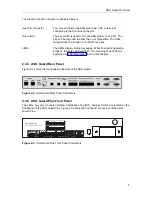
ASG Guard Overview
10
2.8 Logs
The ASG Guard/ASG Guard Plus maintains logs containing details of alarms, accesses, host port
activity, and system information. These logs are useful for site management, security
management, and troubleshooting. All logs are maintained even if the unit is turned off. Each log
type is described below.
Access History - The ASG Guard/ASG Guard Plus records each successful access. The time,
date, user ID, duration of session and type of session are included in each record.
Failure History - The Failure History Log records failed access attempts. The log includes the
date, time, user ID, the port accessed and the reason for failure.
Log History - This log records the activity of the ASG Guard/ASG Guard Plus and the devices to
which it is connected. Activities include modem connections, received calls, Sysop sessions, and
detected alarms and events.
Error Logs - The Error Log contains information regarding errors in System or User written
routines.
2.9 Network
Capabilities
The ASG Guard/ASG Guard Plus has both an Ethernet and PPP TCP/IP network connections.
Network connections support TELNET to the ASG Guard/ASG Guard Plus, FTP for buffer and file
delivery, and SNMP for TRAP delivery to network management stations. In addition, ASG
Guard/ASG Guard Plus will route traffic between its network interfaces, allowing it to act as a
secure remote access server for maintenance applications.
To administer information inside the ASG Guard/ASG Guard Plus, you must establish a SYSOP
session. This can be done at the locally connected terminal (AUX port), through a dial-up
connection, or through a TELNET session. Once a SYSOP session has been established,
administration of the ASG Guard/ASG Guard Plus is through SYSOP Commands that are
grouped by function into menus.
Menus are displayed by typing one of the single character SYSOP commands listed below and
continued on the following page:
Command
Menu
Description
U
User Maintenance
Functions
Commands to modify the user database are
displayed.
S
System Functions
Commands to specify site and scheduling
information are displayed.
A
Action and Alarm
Functions
Commands to view and modify the Action Table are
displayed.
L
Log Functions
Commands to view and modify logs are displayed.
F
File Maintenance
Commands to configure file buffering and manage
files are displayed.
P
Port and Session Control
Functions
Commands to view port status, port signals, and
host session, and to display and modify network
parameters are displayed.
Summary of Contents for Lucent Technologies Access Security Gateway Guard
Page 12: ...x Page intentionally left blank ...
Page 28: ...ASG Guard Overview 16 Page intentionally left blank ...
Page 36: ...Physical Connections 24 Page intentionally left blank ...
Page 60: ...Modem Port Setup 48 Page intentionally left blank ...
Page 82: ...Modifying the User Database 70 Page intentionally left blank ...
Page 120: ...Action and Event Tables 108 Page intentionally left blank ...
Page 158: ...User Connectivity 146 Page intentionally left blank ...
Page 188: ...Log Functions 176 Page intentionally left blank ...
Page 236: ...Troubleshooting 224 Page intentionally left blank ...
Page 252: ...Internal Battery Replacement 240 Page intentionally left blank ...
Page 258: ...Glossary of Command References 246 Page intentionally left blank ...
















































